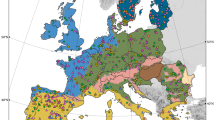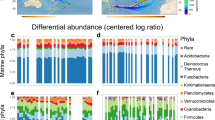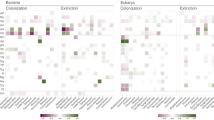Abstract
Although bacteria are ubiquitous in the near-surface atmosphere and they can have important effects on human health, airborne bacteria have received relatively little attention and their spatial dynamics remain poorly understood. Owing to differences in meteorological conditions and the potential sources of airborne bacteria, we would expect the atmosphere over different land-use types to harbor distinct bacterial communities. To test this hypothesis, we sampled the near-surface atmosphere above three distinct land-use types (agricultural fields, suburban areas and forests) across northern Colorado, USA, sampling five sites per land-use type. Microbial abundances were stable across land-use types, with ∼105–106 bacterial cells per m3 of air, but the concentrations of biological ice nuclei, determined using a droplet freezing assay, were on average two and eight times higher in samples from agricultural areas than in the other two land-use types. Likewise, the composition of the airborne bacterial communities, assessed via bar-coded pyrosequencing, was significantly related to land-use type and these differences were likely driven by shifts in the sources of bacteria to the atmosphere across the land-uses, not local meteorological conditions. A meta-analysis of previously published data shows that atmospheric bacterial communities differ from those in potential source environments (leaf surfaces and soils), and we demonstrate that we may be able to use this information to determine the relative inputs of bacteria from these source environments to the atmosphere. This work furthers our understanding of bacterial diversity in the atmosphere, the terrestrial controls on this diversity and potential approaches for source tracking of airborne bacteria.
Similar content being viewed by others
Log in or create a free account to read this content
Gain free access to this article, as well as selected content from this journal and more on nature.com
or
References
Abdelzaher AM, Wright ME, Ortega C, Solo-Gabriele HM, Miller G, Elmir S et al. (2010). Presence of pathogens and indicator microbes at a non-point source subtropical recreational marine beach. Appl Environ Microbiol 76: 724–732.
Albrecht A, Witzenberger R, Bernzen U, Jackel U. (2007). Detection of airborne microbes in a composting facility by cultivation based and cultivation-independent methods. Ann Agric Environ Med 14: 81–85.
Amato P, Ménager M, Sancelme M, Laj P, Mailhot G, Delort A-M . (2005). Microbial population in cloud water at the Puy de Dôme: Implications for the chemistry of clouds. Atmos Environ 39: 4143–4153.
Angenent LT, Kelley ST, Amand A, Pace NR, Hernandez MT . (2005). Molecular identification of potential pathogens in water and air of a hospital therapy pool. Proc Natl Acad Sci USA 102: 4860–4865.
Bauer H, Giebl H, Hitzenberger R, Kasper-Giebl A, Reischl G, Zibuschka F et al. (2003). Airborne bacteria as cloud condensation nuclei. J Geophys Res 108: 4658–4663.
Beggs CB, Kerr KG . (2000). The threat posed by airborne micro-organisms. Indoor Built Environ 9: 241–245.
Boreson J, Dillner AM, Peccia J . (2004). Correlating bioaerosol load with PM2.5 and PM10cf concentrations: a comparison between natural desert and urban-fringe aerosols. Atmos Environ 38: 6029–6041.
Bowers RM, Lauber CL, Wiedinmyer C, Hamady M, Hallar AG, Fall R et al. (2009). Characterization of airborne microbial communities at a high-elevation site and their potential to act as atmospheric ice nuclei. Appl Environ Microbiol 75: 5121–5130.
Brodie EL, DeSantis TZ, Moberg Parker JP, Zubietta IX, Piceno YM, Andersen GL . (2007). Urban aerosols harbor diverse and dynamic bacterial populations. Proc Natl Acad Sci USA 104: 299–304.
Brownell MJ, Harwood VJ, Kurz RC, McQuaig SM, Lukasik J, Scott TM . (2007). Confirmation of putative stormwater impact on water quality at a Florida beach by microbial source tracking methods and structure of indicator organism populations. Water Res: Identifying Sources of Fecal Pollution 41: 3747–3757.
Caporaso JG, Bittinger K, Bushman FD, DeSantis TZ, Andersen GL, Knight R . (2010a). PyNAST: a flexible tool for aligning sequences to a template alignment. Bioinformatics 26: 266–267.
Caporaso JG, Kuczynski J, Stombaugh J, Bittinger K, Bushman FD, Costello EK et al. (2010b). QIIME allows analysis of high-throughput community sequencing data. Nat Methods 7: 335–336.
Christner BC, Morris CE, Foreman CM, Cai R, Sands DC . (2008). Ubiquity of biological ice nucleators in snowfall. Science 319: 1214.
Clarke KR, Warwick RM . (2001). A further biodiversity index applicable to species lists: variation in taxonomic distinctness. Mar Ecol-Progress Series 216: 265–278.
Constantinidou HA, Hirano SS, Baker LS, Upper CD . (1990). Atmospheric dispersal of ice nucleation-active bacteria: the role of rain. Phytopathology 80: 934–937.
DeSantis TZ, Hugenholtz P, Larsen N, Rojas M, Brodie EL, Keller K et al. (2006). Greengenes, a chimera-checked 16S rRNA gene database and workbench compatible with ARB. Appl Environ Microbiol 72: 5069–5072.
Despres V, Nowoisky J, Klose M, Conrad R, Andreae MO, Poschl U . (2007). Molecular genetics and diversity of primary biogenic aerosol paricles in urban, rural, and high-alpine air. Biogeosci Discuss 4: 349–384.
Despres VR, Nowoisky JF, Klose M, Conrad R, Andreae MO, Poschl U . (2007). Characterization of primary biogenic aerosol particles in urban, rural, and high-alpine air by DNA sequence and restriction fragment analysis of ribosomal RNA genes. Biogeosciences 4: 1127–1141.
Fabian MP, Miller SL, Reponen T, Hernandez MT . (2005). Ambient bioaerosol indices for indoor air quality assessments of flood reclamation. J Aerosol Sci 36: 763–783.
Fierer N, Hamady M, Lauber CL, Knight R . (2008a). The influence of sex, handedness, and washing on the diversity of hand surface bacteria. Proc Natl Acad Sci USA 105: 17994–17999.
Fierer N, Liu Z, Rodriguez-Hernandez M, Knight R, Henn M, Hernandez MT. (2008b). Short-term temporal variability in airborne bacterial and fungal populations. Appl Environ Microbiol 74: 200–207.
Fierer N, CL Lauber CL, Zhou N, McDonald D, Costello EK, Knight R . (2010). Forensic identification using skin bacterial communities. Proc Natl Acad Sci USA 107: 6477–6481.
Gonzalez AJ, Landeras E, Mendoza MC . (2000). Pathovars of Pseudomonas syringae causing bacterial brown spot and halo blight in Phaseolus vulgaris L. are distinguishable by ribotyping. Appl Environ Microbiol 66: 850–854.
Hamady M, Lozupone C, Knight R . (2009). Fast UniFrac: facilitating high-throughput phylogenetic analyses of microbial communities including analysis of pyrosequencing and PhyloChip data. ISME J 4: 17–27.
Hamady M, Walker JJ, Harris KJ, Gold NJ, Knight R . (2008). Error-correcting barcoded primers for pyrosequencing hundreds of samples in multiplex. Nat Methods 5: 235–237.
Hussman T . (1996). Health effects of indoor-air microorganisms. Scand J Work Environ Health 22: 5–13.
Jaenicke R . (2005). Abundance of cellular material and proteins in the atmosphere. Science 308: 73.
Jones M, Harrison RM . (2004). The effects of meteorological factors on atmospheric bioaerosol concentrations - a review. Sci Total Environ 326: 151–180.
Lange J, Thorne P, Lynch N . (1997). Application of flow cytometry and fluorescent in situ hybridization for assessment of exposures to airborne bacteria. Appl Environ Microbiol 63: 1557–1563.
Lauber CL, Hamady M, Knight R, Fierer N . (2009). Pyrosequencing-based assessment of soil pH as a predictor of soil bacterial community structure at the continental scale. Appl Environ Microbiol 75: 5111–5120.
Li W, Godzik A . (2006). Cd-hit: a fast program for clustering and comparing large sets of protein or nucleotide sequences. Bioinformatics 22: 1658–1659.
Li W, Jaroszewski L, Godzik A . (2001). Clustering of highly homologous sequences to reduce the size of large protein databases. Bioinformatics 17: 282–283.
Li W, Jaroszewski L, Godzik A . (2002). Tolerating some redundancy significantly speeds up clustering of large protein databases. Bioinformatics 18: 77–82.
Lighthart B . (1997). The ecology of bacteria in the alfresco atmosphere. FEMS Microbiol Ecol 23: 263–274.
Lighthart B, Shaffer BT. (1994). Bacterial flux from chaparral into the atmosphere in mid-summer at a high desert location. Atmospheric Environ 28: 1267–1274.
Lighthart B, Shaffer BT. (1995a). Viable bacterial aerosol particle size distributions in the midsummer atmosphere at an isolated location in the high desert chaparral. Aerobiologia 11: 19–25.
Lighthart B, Shaffer BT . (1995b). Airborne bacteria in the atmosphere surface layer: temporal distribution above a grass seed field. Appl Environ Microbiol 61: 1492–1496.
Lindemann J, Upper CD . (1985). Aerial dispersal of epiphytic bacteria over bean plants. Appl Environ Microbiol. 50: 1229–1232.
Lindow SE, Arny DC, Upper CD . (1978). Distribution of ice nucleation-active bacteria on plants in nature. Appl. Environ. Microbiol. 36: 831–838.
Liu Z, DeSantis TZ, Andersen GL, Knight R . (2008). Accurate taxonomy assignments from 16S rRNA sequences produced by highly parallel pyrosequencers. Nucl Acids Res 36: e120–e130.
Lozupone CA, Hamady M, Kelley ST, Knight R . (2007). Quantitative and qualitative {beta} diversity measures lead to different insights into factors that structure microbial communities. Appl Environ Microbiol 73: 1576–1585.
Maki LR, Galyan EL, Chang-Chien M-M, Caldwell DR . (1974). Ice nucleation induced by Pseudomonas syringae. Appl Environ Microbiol 28: 456–459.
Maron P-A, Lejon DPH, Carvalho E, Bizet K, Lemanceau P, Ranjard L et al. (2005). Assessing genetic structure and diversity of airborne bacterial communities by DNA fingerprinting and 16S rDNA clone library. Atmospheric Environ 39: 3687–3695.
Matthias-Maser S, Jaenicke R . (2000). The size distribution of primary biological aerosol particles in the multiphase atmosphere. Aerobiologia 16: 207–210.
Menetrez MY, Foarde KK, Esch RK, Dean TR, Betancourt DA, Moore SA et al. (2007). The measurement of ambient bioaerosol exposure. Aerosol Sci Technol 41: 884–893.
Mohler O, DeMott PJ, Vali G, Levin Z . (2007). Microbiology and atmospheric processes: the role of biological particles in cloud physics. Biogeosciences Discuss 4: 2559–2591.
Mohler O, Georgakopoulos DG, Morris CE, Benz S, Ebert V, Hunsmann S et al. (2008). Heterogeneous ice nucleation activity of bacteria: new laboratory experiments at simulated cloud conditions. Biogeosciences 5: 1425–1435.
Nemecek-Marshall M, LaDuca R, Fall R . (1993). High-level expression of ice nuclei in a Pseudomonas syringae strain is induced by nutrient limitation and low temperature. J Bacteriol 175: 4062–4070.
O’Brien RD, Lindow SE . (1988). Effect of plant species and environmental conditions on ice nucleation activity of Pseudomonas syringae on leaves. Appl Environ Microbiol 54: 2281–2286.
Pace NR . (1997). A molecular view of microbial diversity and the biosphere. Science 276: 734–740.
Price MN, Dehal PS, Arkin AP . (2009). FastTree: computing large minimum evolution trees with profiles instead of a distance matrix. Mol Biol Evol 26: 1641–1650.
Radosevich JL, Wilson WJ, Shinn JH, DeSantis TZ, Andersen GL . (2002). Development of a high-volume aerosol collection system for the identification of air-borne micro-organisms. Lett Appl Microbiol 34: 162–167.
Redford A, Bowers RM, Knight R, Linhart Y, Fierer N . The ecology of the phyllosphere: geographic and phlyogenetic variability in the distribution of bacteria on tree leaves. Environ Microbiol, 2010; e-pub ahead of print 1 June 2010, doi:10.1111/j.1462-2920.2010.02258.x.
Romantschuk M, Bamford DH . (1986). The causal agent of halo blight in bean, pseudomonas syringae pv. phaseolicola, attaches to stomata via its pili. Microb Pathog 1: 139–148.
Schwartz D, Thorne P, Yagla SJ, Burmeister LF, Olenchock SA, Watt JL et al. (1995). The role of endotoxin in grain dust-induced lung disease. Am J Respir Crit Care Med 152: 603–608.
Tong Y, Lighthart B. (1998). Effect of simulated solar radiation on mixed outdoor atmospheric bacterial populations. FEMS Microbiol Ecol 26: 311–316.
Tong Y, Lighthart B. (2000). The annual bacterial particle concentration and size distribution in the ambient atmosphere in a rural area of the Willamette Valley, Oregon. Aerosol Sci Technol 32: 393–403.
Vali G. (1971). Quantitative evaluation of experimental results on the heterogeneous freezing nucleation of supercooled liquids. Journal of Atmospheric Sciences 28: 402–409.
Vali G, Christensen M, Fresh RW, Galyan EL, Maki LR, Schnell RC . (1976). Biogenic ice nuclei. Part II: bacterial sources. Journal of the Atmospheric Sciences 33: 1565–1570.
Wang Q, Garrity GM, Tiedje JM, Cole JR . (2007). Naive Bayesian classifier for rapid assignment of rRNA sequences into the new bacterial taxonomy. Appl Environ Microbiol 73: 5261–5267.
Wery N, Monteil C, Pourcher A-M, Godon J-J. (2010). Human-specific fecal bacteria in wastewater treatment plant effluents. Water Res 44: 1873–1883.
Wilson KH, Wilson WJ, Radosevich JL, DeSantis TZ, Viswanathan VS, Kuczmarski TA et al. (2002). High-density microarray of small-subunit ribosomal DNA probes. Appl Environ Microbiol 68: 2535–2541.
Acknowledgements
We would like to thank Donna Berg-Lyons for her assistance with the pyrosequencing preparation, Jesse Stombaugh for his assistance with the bioinformantics, Dr Ray Fall for providing access to the equipment used for the ice nucleation assays, and Dr John Basey for providing us with access to a fluorescent microscope. We would also like to thank members of the Fierer lab for their helpful input on this paper. This study was supported by grants to N.F. from the Cooperative Institute for Research in Environmental Sciences, the National Science Foundation and the U.S. Department of Agriculture.
Author information
Authors and Affiliations
Corresponding author
Additional information
Supplementary Information accompanies the paper on The ISME Journal website
Rights and permissions
About this article
Cite this article
Bowers, R., McLetchie, S., Knight, R. et al. Spatial variability in airborne bacterial communities across land-use types and their relationship to the bacterial communities of potential source environments. ISME J 5, 601–612 (2011). https://doi.org/10.1038/ismej.2010.167
Received:
Revised:
Accepted:
Published:
Issue date:
DOI: https://doi.org/10.1038/ismej.2010.167
Keywords
This article is cited by
-
Spatial variation of airborne bacterial heterogeneity and potential opportunistic human pathogens: a comparative study of sites in Korea and Japan
Aerobiologia (2024)
-
Long-read sequencing of metagenomes from wet deposition samples in the Western USA during an elevated precipitation in February 2019
Aerobiologia (2024)
-
A new approach of microbiome monitoring in the built environment: feasibility analysis of condensation capture
Microbiome (2023)
-
Enrichment of human nasopharyngeal bacteriome with bacteria from dust after short-term exposure to indoor environment: a pilot study
BMC Microbiology (2023)
-
A critical review on bioaerosols—dispersal of crop pathogenic microorganisms and their impact on crop yield
Brazilian Journal of Microbiology (2023)



